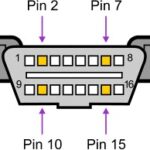For Jeep Grand Cherokee 2012 owners looking to delve deeper into their vehicle’s performance and health, OBDII apps offer a powerful solution. When paired with an iPhone and a compatible OBDII adapter, apps like Torque Pro provide real-time data and insights directly to your fingertips. This article explores the capabilities of using an OBDII iPhone app with a 2012 Jeep Grand Cherokee, focusing on the experiences and parameters you can monitor.
Torque Pro, a robust OBDII application, stands out with its extensive features, including a PID scanner, allowing users to access a wide range of sensor data from their vehicle’s engine and systems. One key parameter for performance monitoring is Exhaust Gas Temperature (EGT). On a Jeep Grand Cherokee 2012, the pre-turbo EGT sensor, identified as PID 78 in Torque Pro, offers immediate feedback on engine temperature. This sensor reacts rapidly to throttle input, quickly climbing to 1300°F under Wide Open Throttle (WOT) conditions. Monitoring pre-turbo EGT is crucial for understanding engine load and preventing potential overheating issues, especially during demanding driving conditions.
Further downstream in the exhaust system, the catalytic converter temperature sensor (CAT B1S1), located after the Diesel Particulate Filter (DPF), provides a different perspective on exhaust temperature. This sensor reacts much more slowly than the pre-turbo EGT and generally stays below 1000°F in normal driving. However, during a DPF regeneration cycle, the CAT B1S1 temperature can fluctuate between 1000°F and 1300°F. Setting up an alert in Torque Pro to trigger when CAT B1S1 exceeds 1000°F can be a helpful indicator of an active regeneration process. This is particularly useful for understanding your Jeep’s emissions system behavior and ensuring optimal DPF function. Additionally, towing heavy loads uphill can also cause this temperature to rise above the typical range, reflecting increased engine and exhaust system workload.
Boost pressure is another vital parameter for turbocharged engines like those found in some Jeep Grand Cherokee 2012 models. While Torque Pro provides boost readings, users may find a slight discrepancy requiring a calibration adjustment. In one user’s experience, the initial boost reading was consistently 2.2 psi lower than expected. By applying a correction factor within Torque Pro, accurate boost readings can be achieved. After correction, WOT runs indicated boost pressures in the 21-23 psi range, aligning with expected performance levels. Accurate boost monitoring is essential for diagnosing performance issues and ensuring the turbocharger system is operating within its intended parameters.
Engine oil temperature is also readily accessible through OBDII and Torque Pro. The oil temperature readings in Torque Pro closely mirrored the Engine Vehicle Information Center (EVIC) display in the Jeep Grand Cherokee 2012. While the EVIC might exhibit a slight delay in updating compared to Torque Pro, likely due to data buffering for display stability, both sources provided consistent temperature information. Monitoring oil temperature is important for assessing engine health and ensuring proper lubrication, especially under heavy load or extreme temperatures.
Coolant temperature monitoring via Torque Pro further validated the accuracy of the vehicle’s cluster gauge. Observations revealed that the midpoint on the cluster gauge corresponded to approximately 201°F, and the start of the red zone likely indicated around 230°F. During demanding conditions, such as towing a travel trailer up a 6% grade at around 47 mph, the coolant temperature stabilized around 220°F. This real-time coolant temperature data from Torque Pro provides a more precise reading than the cluster gauge and can be invaluable for preventing overheating and managing engine temperature effectively.
Beyond these parameters, further insights can be gained by monitoring additional data points such as fuel rail pressure, oil pressure, injector duty cycle, and transmission temperature. While the EVIC in the Jeep Grand Cherokee 2012 may display transmission temperature, accessing these other parameters through Torque Pro provides a more comprehensive view of the engine and drivetrain performance. Monitoring fuel rail pressure is crucial for diagnosing fuel delivery issues, while oil pressure is a direct indicator of engine lubrication system health. Injector duty cycle provides insight into engine load and fuel consumption, and precise transmission temperature monitoring is vital for preventing transmission overheating and ensuring longevity, especially during towing or off-road driving.
In conclusion, utilizing an OBDII iPhone app like Torque Pro with a 2012 Jeep Grand Cherokee offers a significant advantage for vehicle owners seeking detailed performance and diagnostic information. By monitoring parameters like EGT, CAT B1S1, boost, oil temperature, and coolant temperature, users can gain a deeper understanding of their Jeep’s operation and proactively address potential issues. Exploring further parameters like fuel rail pressure, oil pressure, injector duty cycle, and transmission temperature can further enhance this diagnostic capability, making the combination of an OBDII iPhone app and a 2012 Jeep Grand Cherokee a powerful tool for informed vehicle ownership and maintenance.

